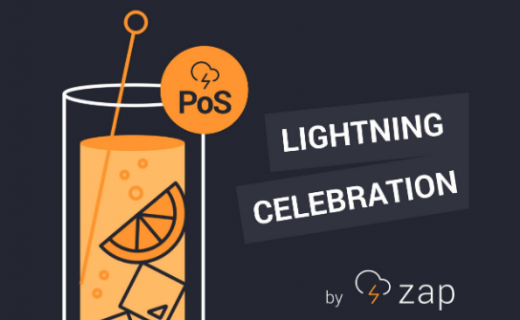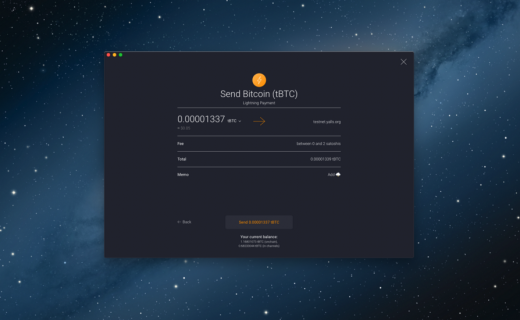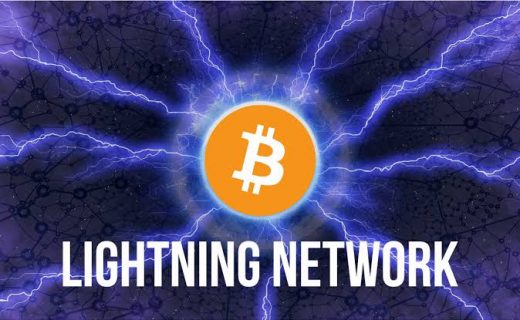Lightning Network will transform Bitcoin and offer instant and almost free transactions solving the most pressing problems of transactions speed and costs. It can also offer so much more. Lightning is where we will transact on. Lightning is what everything will be built on to really scale Bitcoin. Lightning is what will power and enable our applications and additional protocols and layers.
How Lightning Network Works
The concept of Lighting Network (LN) is that most payments need not be recorded in bitcoin’s ledger. Instead, they can take place in private channels between users. The Lightning Network’s builders seek to move the bulk of everyday payments to private channels and use the blockchain as the ultimate secure ledger.
The way it works is that two parties can open a channel and commit funds to it. The opening of a channel gets broadcast to the blockchain and incurs the normal bitcoin transaction fee. The channel can stay open for an undefined amount of time during which time the users of the channel can exchange as many payments as they like for free. When the channel is closed it broadcasts the final state of the pair’s transactions to the bitcoin blockchain, incurring another transaction fee. If there is a dispute the aggrieved party can broadcast the contested transaction to the blockchain, where other users can verify it and miners can update the ledger, forcing the offender to forfeit funds. In addition if one party leaves the channel, timelock contracts on the blockchain can be used to retrieve your funds.
As long as a channel stays open, payments within it are free. Because they don’t rely on the blockchain, they can be completed at internet speeds. However, the real innovation occurs when those channels stay open indefinitely, potentially even for decades, and when they connect into networks of other channels. The system’s design includes extra cryptographic features that allow a user to safely send payments not only through their direct connections but across their extended networks.
This aspect is vital, because it means a user only needs to open, and pay the transaction fees for, a small number of private channels in order to do commerce across the whole network. The code underlying the Lightning Network can find a path between a user’s immediate connections to more distant parties in the network, in a design akin to internet routing. Comparing LN to internet routing is really good way to visualize the the way it can scale globally in the same way that the internet has scaled.
There is a good correlation between understanding how computer networks and the Internet works that can be applied to Bitcoin’s own scaling problems. If we examine the three protocols of the internet, Ethernet, IP, and TCP we can answer the great ‘scaling’ question for Bitcoin and all blockchains alike.
Blockchain transactions resemble Broadcast-like forms of communication. When a transaction is made on the Bitcoin network, the transaction is communicated or broadcasted to all connected nodes on the network. In other words, for a transaction to exist or happen in Bitcoin, all nodes must receive and record this transaction. Transactions on blockchains work in a similar manner to the way ethernet hubs handled data transmissions.
Originally we relied on ethernet hubs to transfer data between computers. Then we discovered that they simply did not scale due to their limited nature. Old ethernet hubs strictly supported broadcast transmissions, data that would come in through one interface or port would need to be broadcasted and replicated out through all other ports on the network. Imagine if you wanted to send me a 1MB image file over a network with 100 participants, that 1MB image file would, in turn, need to be replicated 99 times and broadcasted out to all other users on the network.
This is very similar to the way Bitcoin works, data (a transaction or block) that comes from one node is broadcasted and replicated to all other nodes on the network. Blockchains are simply poor mediums to perform data transmission and communicate over as it is designed mainly for security through verification.
In modern computer networks, the most frequent form of communication relies on unicast data transmissions, or point-to-point. Most of the communication on the internet is routed from one computer to another. Files can be accurately sent, routed and delivered to the receiving party(ies). The transfer of a 1MB image file in a broadcast network would require the file to be replicated and broadcasted to every participant on that network. Instead, in a network that supports unicast data transmissions, that image file can move from source to destination in a clearcut manner.
The Lightning Network is the IP layer of Bitcoin. LN allows us to lock our Bitcoin and form channels with others. What It bidirectionally send and receive transactions between the two points that constitute the channel and it route transactions to their correct destination. LN enables unicast transactions in Bitcoin, that previously only supported broadcast transactions. Lightning nodes in Bitcoin are the equivalent of IP hosts — that can finally conduct or route one-to-one or point-to-point transactions to their appropriate recipients. In traditional IP, data is sent and received in packets; in Lightning, you can send and receive bitcoin.
IP is what allowed the internet to scale from a small and largely primitive network of the past into the global giant that it is today. In a similar manner, Lightning will allow the Bitcoin network to scale globally. Bitcoin itself will remain a decentralized, tamper-proof, immutable base or foundation layer which will provide us with cryptographic evidence of what is a Bitcoin.
Some individuals and groups within the crypto communities spread fear and warn of false narratives of “lightning hubs”, but fail to grasp that their scaling approach of on-chain transactions only pushes us in the direction of an actual (ethernet) hub design. If Bitcoin loses decentralization on its base layer, then we will lose Bitcoin. The past 9 years of work will have only resulted in a large, centralized broadcast hub with only a few nodes remaining and only a few companies with the ability to operate and maintain it.
When will Lightning Network be ready?
It is currently live on the Mainnet, but caution is advised when using it at this early stage of development. Last month the isolated groups developing the network, banded together and released a “1.0” version. It has hosted its first successful payments, with developers spending bitcoin to purchase articles on Y’alls, a micropayment blogging site built for demonstration purposes by programmer Alex Bosworth. In a live but isolated test last month, Bosworth separately used the network to pay a phone bill with his own bitcoin. As he tweeted in late December, “Speed: Instant. Fee: Zero. Future: Almost Here.” And this week Blockstream launched an ecommerce site selling t-shirts and stickers that only accepts Lightning payments.
Mainnet Lightning Network paying my actual phone bill with actual Mainnet funds on @bitrefill. Speed: Instant. Fee: Zero. Future: Almost Here. pic.twitter.com/futhn502Lp
— Alex Bosworth ☇ (@alexbosworth) December 28, 2017
Rusty Russell, a developer at Blockstream said:
“When you first heard about bitcoin, you probably heard about ‘instant payments around the world for free. But if you dug into it, it wasn’t really that cheap, and it was never instant. Lightning actually does those things.”
Interest in the project jumped after three teams announced that their separate implementations worked together as one larger network. Acinq CEO Pierre-Marie Padiou reports that downloads of his startup’s Lightning mobile wallet (the software that stores the private keys needed to spend one’s bitcoin) shot over 4,000. Lightning Labs, meanwhile, has attracted more than 1,000 participants to its public Slack room, where they ask questions of the developers, contribute code or flag bugs.
Drumroll … Announcing⚡️Lightning Protocol 1.0: Compatibility Achieved ✅
Very proud of the work we accomplished as a community with @lightning @Blockstream and all contributors and testers!https://t.co/ygdoODKPX0 #bitcoin #bitcoinlightning
— ACINQ (@acinq_co) December 6, 2017
Who is behind the development of the Lighting Network?
The idea for Lighting Network came about in 2014, when Joseph Poon and Thaddeus Dryja, both computer engineers in San Francisco would discuss Bitcoin technology. They were preoccupied with making bitcoin more useful. They could see that the bitcoin network’s design limited it to only three to seven transactions per second, compared with tens of thousands per second for a payment system like Visa. They recognized that for bitcoin to reach its full potential, it needed a scaling and speed solution.
After several months of work they revealed their work at a San Francisco bitcoin meetup. They called it the Lightning Network, a system that can be built off-chain and sit on top of the blockchain. With this extra layer of code in place, they believed, bitcoin could support far more transactions and make them almost-instant, reliable and cheap, while remaining free of banks and other institutions.
As their paper propagated around the internet, blockchain engineers started discussing its technical details and how to turn the ideas into working code. In Australia, a Blockstream engineer called Rusty Russell was the first to try implementing it in the summer of 2015. Also around that time, a French bitcoin startup called Acinq began shifting from building a hardware wallet to devoting itself to Lightning. That fall Poon and Dryja partnered with a fellow enthusiast, Elizabeth Stark, to launch Lightning Labs. A quarrel splintered the founding team and Poon and Dryja went their separate ways, but Lightning Labs is now leading the overall network development effort with a rebuilt engineering team. In the video below Elizabeth Stark presents LN and discusses it’s importance as a ‘Layer Two’ solution.
It is very important to note there are still some bugs. One particularly bad bug is that if you make a backup of your bitcoin wallet—on another computer or a USB drive, say—and decide to restore from the backup, you can accidentally claim money you’ve already spent. When that happens, the Lightning Network protocol allows your counterparty to take over all the funds in your channel. This problem highlights the work to be done before the Lightning Network is ready for wide adoption.
Some entrepreneurs are willing to gamble on Lightning today. Last week a VPN provider called TorGuard may have become the first company to announce it will accept payments made through the Lightning Network. But it cautioned in a tweet that the network “is not production ready” and that the company would cover any lost payments. For now, Lightning’s users are hardcore bitcoin enthusiasts willing to risk some satoshi to bask in the glory of being first.





Comments are off this post!